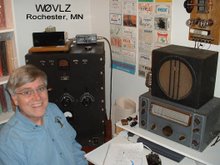One receiver that I like to use as an example of early novice class gear is my National NC-57. It is a good vintage and performance match for transmitters like the Johnson Adventurer and Heathkit AT-1.
Unfortunately, like most two dial sets, the bandspread is designed to cover the entire 500KHz 80 mtr band. The 25 KHz of 80 that I'm most interested cover only 4 divisions (out of 100) on the dial. Bandspread on 40 is little better. I needed to bandspread the bandspread. This modification is reversible and changes those 25 KHz of 80 to cover 45 divisions on the dial instead of 4. Now I have a chance of grabbing the right crystal when answering a CQ and easily tuning in a station with the Q-Multiplier turned on.
Basically this change greatly reduces the effective value of the bandspread capacitor. This can be done by removing rotor plates from the bandspread capacitor but a simpler change is to put a low value capacitor in series with each section of the bandspread capacitor.
You'll need three 10 pf capacitors.
Using a fine tooth hack saw blade carefully cut the three wires between the main and bandspread capacitors. After cutting these three wires your NC-57 should behave normally except it will have no bandspread.
Solder three 10 pf capacitors between the main and bandspread capacitors electrically replacing the three wires just cut.
That's it electrically but you'll probably also want to make up calibration curves for you favorite parts of the bands.
**** Warning Warning ****
When cutting the three connections between the main tuning and bandspread capacitors there is a chance something will go wrong. You may be able to fix it by running an interconnect jumper across the top (insead of capacitors) or you may have a boat anchor in the nautical sense...sorry.










